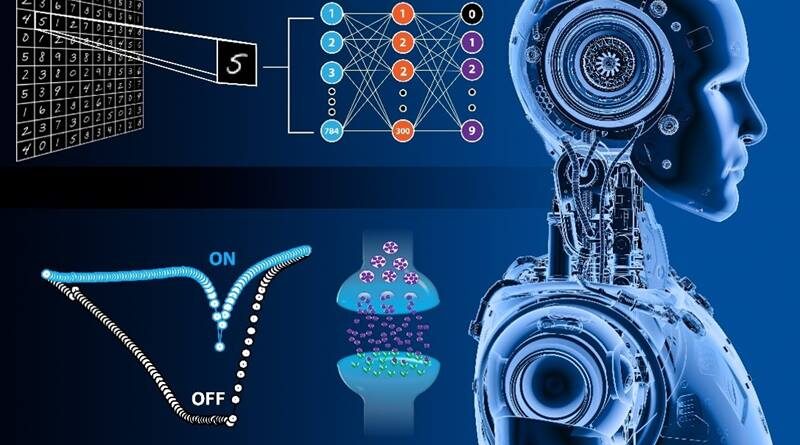An Emerging Device Empowers Neuromorphic Computing
Science
A modern device with metal, dielectric, and metal components remembers the history of the electrical signals sent through it. This device, called a memristor, can serve as the basis of neuromorphic computers – computers that work in the same way as the human brain. Unlike traditional digital memory, which stores information as 0s and 1s, this device exhibits so-called “analog” behavior. This means that the device can store information between 0 and 1, and can mimic how synapses work in the brain. The researchers found that the connection between the metal and the dielectric in the novel device is essential for stable switching and improved performance. Simulations show that circuits built on this device show improved image recognition.
Influence
Today’s computers are not well suited for big data and machine learning tasks. By 2030, experts predict that data centers could use up to 8% of the world’s electricity. To address this challenge, researchers are working to create computers inspired by the human brain, called neuromorphic computers. Artificial synapses made of memristor devices are the building blocks of these computers. These artificial synapses can store and process information in one place, similar to how neurons and synapses work in the brain. Combining these emerging tools with standard computer components will reduce energy requirements and improve performance for tasks such as artificial intelligence and machine learning.
Summary
Scientists at the Center for Integrated Nanotechnologies at Los Alamos National Laboratory and their colleagues have created artificial synaptic devices and discovered that the interface properties between metal and dielectric layers in those devices play an important role in the identification equipment resistance levels. This conversion process is important for using these tools for real-world applications. Because the switching device is controlled by the interface, these new devices offer many advantages over conventional computer devices, including analog-type memory, uniform modulation, low consumption of power, and high scalability.
Research has shown that a simple two-terminal device simulates many synaptic functions in the brain. To take learning as an example, in systems biology, learning is related to a mechanism called “spike-timing-dependent plasticity,” which adjusts the strength of connections between neurons in the brain. Two neurons are connected by a synapse and the strength of the connection is called “synaptic weight.” This density or strength of connection between two neurons changes depending on the relative firing time of the neuron. This process is important to our learning and memory. These memristor devices work in the same way. The resistance level of these devices represents the synaptic load and can be controlled by electrical currents. To demonstrate their potential applications, the researchers simulated an artificial network with this link-type memristor device, and then tested the network’s ability to recognize images of the Modified National Institute of Standards and Technology (MNIST) digital. The simulated neural network recognized these images with high accuracy after several training sessions.
Get in touch
Aiping Chen
Center for Integrated Nanotechnologies
apchen@lanl.gov
Sundar Kunwar
Center for Integrated Nanotechnologies
sundar@lanl.gov
Financial support
This work was supported primarily by the Department of Energy’s (DOE) National Nuclear Security Administration. The research used facilities at the Center for Integrated Nanotechnology, a user center of the DOE Office of Science. Work at the University at Buffalo and Purdue was supported in part by the National Science Foundation. Additional support was provided by the DOE Graduate Program in Science, the Engineering and Physics Research Council and the Royal Academy of Engineering of the United Kingdom, and the European Union’s Efficient and Robust Oxide Switching project.
Articles
Kunwar, S. and al. An Interface-Type Memristive Device for Artificial Synapse and Neuromorphic Computing. Advanced intelligence systems 5, 2300035 (2023). [DOI: org/10.1002/aisy.202300035]
Kunwar, S. and al. Protons: Key Species for Resistive Switching in Interface-Type Memristors. Advanced Electronics 9, 2200816 (2023). [https://doi.org/10.1002/aelm.202200816]
#Emerging #Device #Empowers #Neuromorphic #Computing
